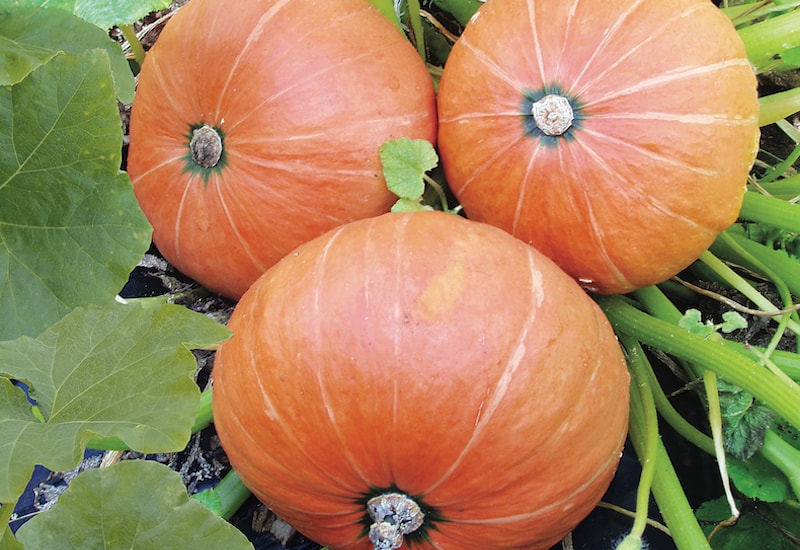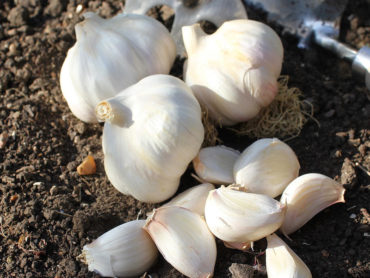Look beyond the cheery orange of the popular Hallowe’en pumpkin and you’ll find a huge variety of pumpkins and squash that are easy to grow from seed. With the right practical guidance you can’t go wrong, which is why we’ve asked our favourite gardening bloggers, YouTube creators and Instagram growers to share the secrets of their success!
From the diminutive ‘Jack Be Little’ pumpkin to the hefty butternut squash, there’s something for everyone. Browse our full range of squash and pumpkin seeds to be spoilt for choice.
Contents:
- Best advice on choosing squash varieties and sowing seeds
- Best advice on planting out squash and pumpkins
- Best advice on harvesting and storing squash and pumpkins
- Best advice on cooking pumpkins and squash
Best advice on choosing squash varieties and sowing seeds
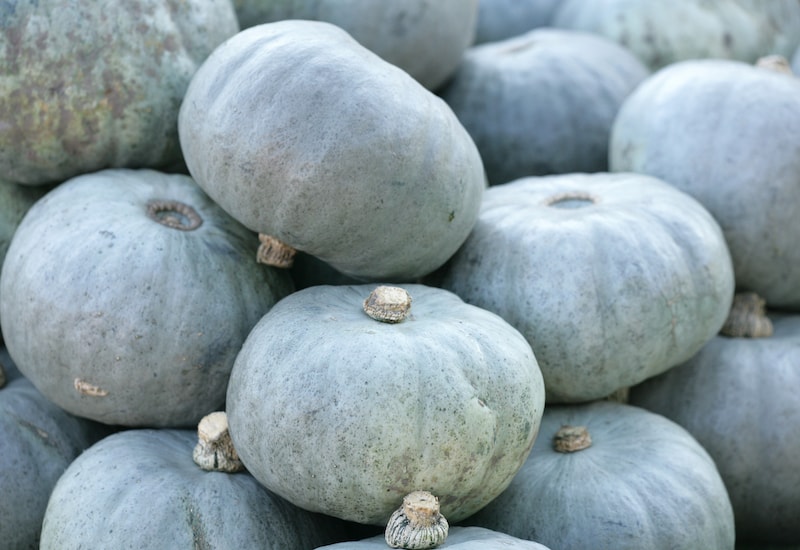
Image: Squash F1 ‘Crown Prince’ from Suttons
Chris @VeggiePlot is a fan of ‘Crown Prince’ squash with its “steely blue skin and rich orange insides that taste nutty when roasted”. Chatting to other gardeners who have commented on his Instagram post, he explains that this variety is “very hungry” but stores really well. Visit Chris’ post to learn about his other all time favourite.
Over at Grow Like Grandad, gardener Matt Peskett prefers the challenge of growing the exhibition pumpkin ‘Atlantic Giant’. Sharing top tips on how to grow giant pumpkins, Matt says that “all the techniques are completely transferable to other squash and pumpkins and they’ll grow better as a result.” Read the full article to learn how to grow a prize-winning pumpkin.
Want to give your pumpkins a head start? Follow the advice of our gardening experts here at Suttons and sow your seeds indoors in April. They recommend placing “the large, flat seeds into the soil on their edge at a depth of about 1cm”. If you prefer to direct sow outdoors, wait until May or June. Check out the full article to learn more about growing pumpkins and winter squash.
In a fantastic guest post published on Lovely Greens, Rachel Guy-Whittle says she loves the way brightly coloured pumpkins and winter squash liven up the autumn garden and make your home “look like a seasonal scene from Good Housekeeping”. As squash don’t like to have their roots disturbed, Rachel sows her seeds in “pots big enough to hold them till they’re ready to be planted out” and keeps them near a radiator to help them germinate.
Best advice on planting out squash and pumpkins

Image: Pumpkin ‘Jack Be Little’ (organic seeds) from Suttons
When planting out your young squash, it’s important to give them enough space to grow, reminds John Harrison of Allotment & Gardens. He says around 1.2m/4ft apart is fine, although they’re also “quite happy growing in a large pot, as long as you feed them well”. When planting, John sits his plants “on a slight mound” and buries “a pot next to the plant, so that it can be fed and watered directly to the roots” – brilliant!
Over on YouTube, Huw Richards demonstrates a slightly different method for planting out his squash. He creates a soil ‘bowl’ around each young plant and then covers the whole bed with black plastic. The ‘bowl’ traps and funnels rainwater directly down to the roots, while the black plastic absorbs heat, warms the bed, and deters weed growth. Watch Huw’s video on the best way to plant out squash to see exactly how he does it.
Although pumpkins traditionally sprawl along the ground, you can still have a successful harvest with limited space, as Ivan demonstrates in his Container Pumpkin video over at Ivan’s Gardening Allotment UK. He grows his miniature pumpkins ‘Jack Be Little’ in a homemade planter and trains the vine up a vertical trellis. Not letting any opportunity go to waste, he interplants a quick lettuce crop in the same container while he waits for his pumpkins to mature. Watch his video for more excellent tips.
Bees and other pollinators are welcome visitors to your newly planted out pumpkins but, to really ensure a successful harvest, Karen at Allotment Haven recommends pollinating by hand. Knowing how to spot the differences between the male and female flowers is crucial. See her images for a definitive guide, and follow her step-by-step instructions to hand-pollinating pumpkins and squash.
Best advice on harvesting and storing squash and pumpkins
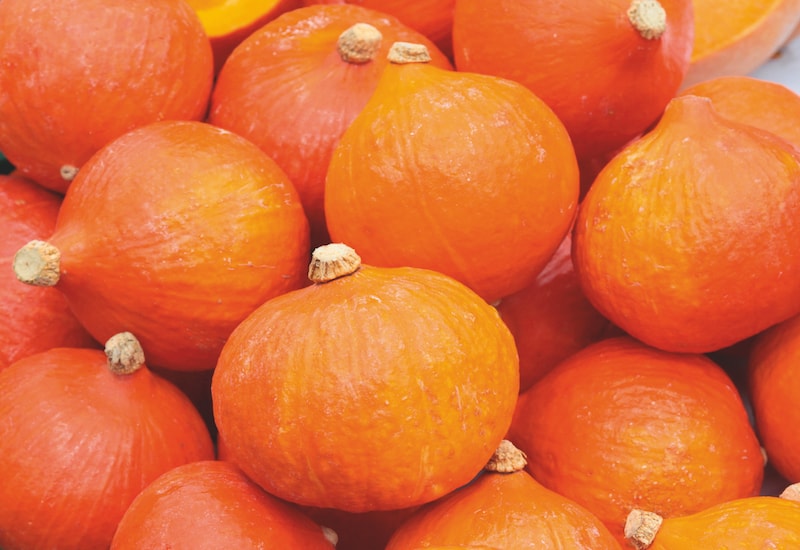
Image: Squash ‘Uchiki Kuri’ from Suttons
How do you know when your squash are ready to harvest? Colour and size are key indicators, explains Tina Lawlor Mottram in her comprehensive Garden Patch article on growing squash vertically. For an abundant harvest, her tip is to cut the first fruit that appears, “even if it’s not quite the desired size. This forces the plant into thinking it had better produce more if one is already gone, so the next fruits will tend to be larger and you can leave them to swell.”
Charles Dowding grows several types of winter squash because varieties such as ‘Crown Prince’ develop thick skins and store well for many months. Charles waits until the leaves on his ‘Crown Prince’ plants start to die off and then harvests the squash by cutting “around the stem rather than cutting into the neck”. Watch his video to see exactly how he prepares his fruits for storage.
Over at @plotandpantry, Penny Foxwell proudly shows us how she ‘cures’ her ‘Crown Prince’ squash “in the sun in the greenhouse” to harden the skins before storing in her pantry. Properly cured winter squash last well into the spring, and Penny’s pantry is full of healthy-looking garden produce. Watch her reel to find out what else she’s cured for long-term storage!
While squash are perfectly edible right off the vine, there are flavour and health benefits to storing them for a while first. Want to know why it’s best NOT to eat squashes fresh? The Suttons hort team explains that storing your squash at a cool 10°C for a month increases its sugar content and carotenoid antioxidants. You can preserve the vitamins even further by cooking your squash in certain ways. Read this fascinating article to learn more.
Best advice on cooking pumpkins and squash
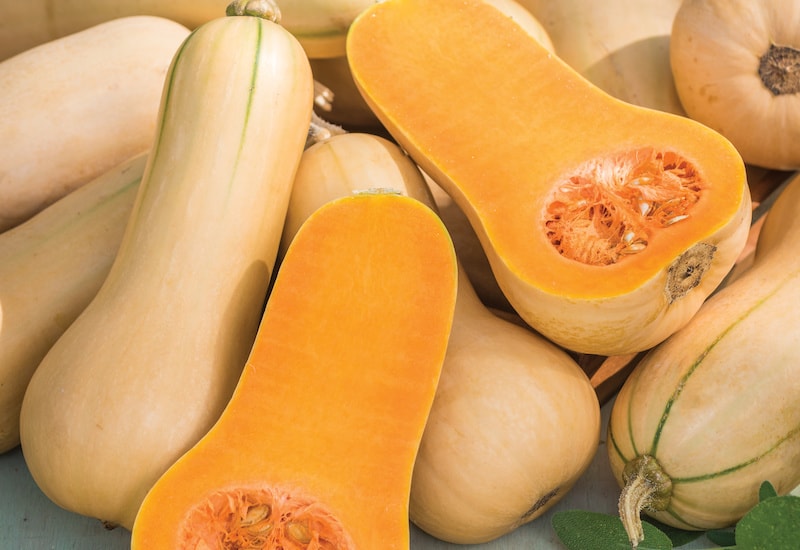
Image: Butternut Squash ‘Butterbush’ F1 from Suttons
At @allotment_and_cake, Hampshire-based allotmenteer Jess harvested some unusual-looking uchiki kuri squash which she suspects were cross-pollinated with a pumpkin. Her plan is to turn the squash into “allotment soup” but she’ll be taste-testing the fruit first “to be sure it hasn’t got the ol’ toxic squash syndrome”. Jess is an enthusiastic grower – check out her Instagram account for inspiring stories, photos and gardening advice.
Let’s all just pause and admire the impressive assortment of pumpkins and squash sitting in the kitchen of gardener and foodie @mileshky. Once chopped and roasted in the oven, these fruits are transformed with shallots and cumin into a hearty autumn soup – it looks delicious! As well as tasting great, Mileshky loves pumpkins because they give you the opportunity to grow more fruit yourself: “they come with free pumpkin seeds inside each one. Like an adult kinder egg.” Good point!
Amy and Paul @allotment14b grow several types of squash on their Basingstoke plot, including the slightly unusual and egg-shaped spaghetti squash which are looking particularly healthy as they climb up their frame. Rewarding to grow, this variety can be roasted and served as a low-carb, high-fibre alternative to pasta.
It isn’t just the flesh of pumpkins and squash that makes for healthy eating. The seeds, seasoned and roasted, also make an excellent snack. Over at Moral Fibres, sustainability expert Wendy shares how to roast butternut squash seeds. Although they can be stored for up to a week in an airtight jar, Wendy warns that they “never last that long!” See her recipe to discover a wealth of fantastic ‘seed snack’ flavours, including some for those with a sweet tooth. Give it a try – it’s eco-friendly and money-saving!
We hope we’ve given you all the information you need to try growing your own squash and pumpkins. Missed the seed sowing window? Don’t worry. Choose a few pumpkin and squash plants for a shortcut to success.
Lead image: Pumpkin ‘Amazonka’ from Suttons
©Branded Garden Products
Last Updated on December 11, 2024 by Suttons Horticultural Team

